Qianyu Yang
Illumination Design for Joint Imaging and Wireless Power Transfer Systems
Aug 01, 2024



Abstract:This paper presents a novel concept termed Integrated Imaging and Wireless Power Transfer (IWPT), wherein the integration of imaging and wireless power transfer functionalities is achieved on a unified hardware platform. IWPT leverages a transmitting array to efficiently illuminate a specific Region of Interest (ROI), enabling the extraction of ROI's scattering coefficients while concurrently providing wireless power to nearby users. The integration of IWPT offers compelling advantages, including notable reductions in power consumption and spectrum utilization, pivotal for the optimization of future 6G wireless networks. As an initial investigation, we explore two antenna architectures: a fully digital array and a digital/analog hybrid array. Our goal is to characterize the fundamental trade-off between imaging and wireless power transfer by optimizing the illumination signal. With imaging operating in the near-field, we formulate the illumination signal design as an optimization problem that minimizes the condition number of the equivalent channel. To address this optimization problem, we propose an semi-definite relaxation-based approach for the fully digital array and an alternating optimization algorithm for the hybrid array. Finally, numerical results verify the effectiveness of our proposed solutions and demonstrate the trade-off between imaging and wireless power transfer.
Beam Focusing for Near-Field Multi-User Localization
Jul 24, 2024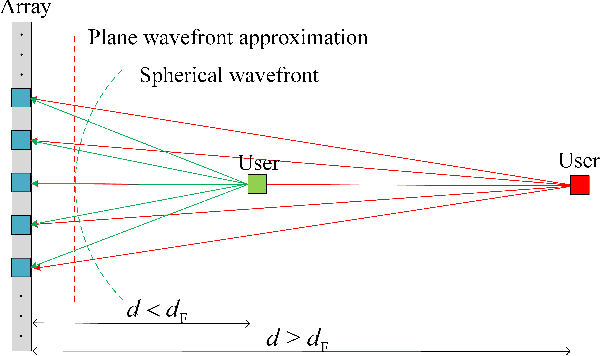
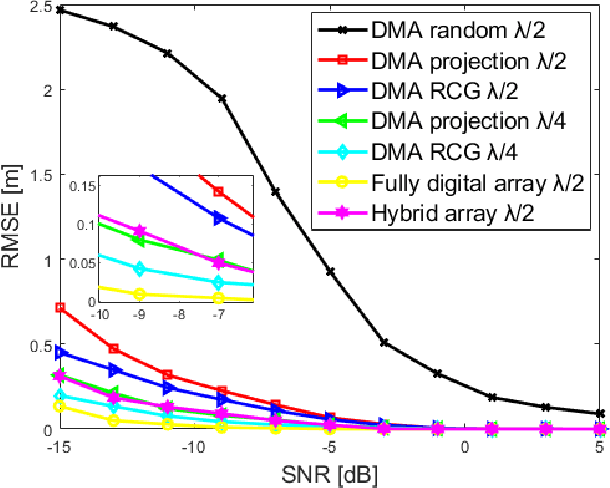
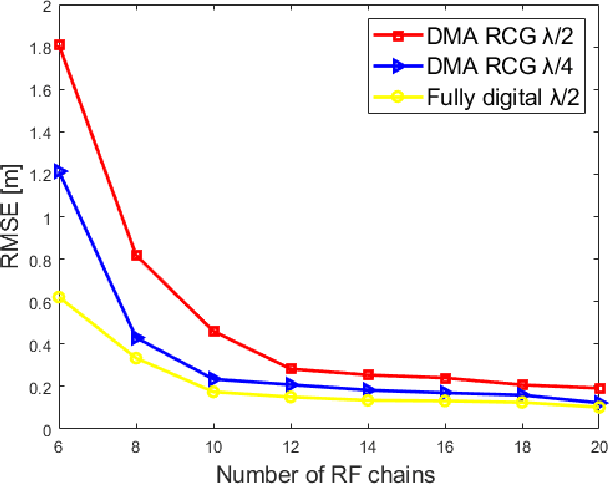
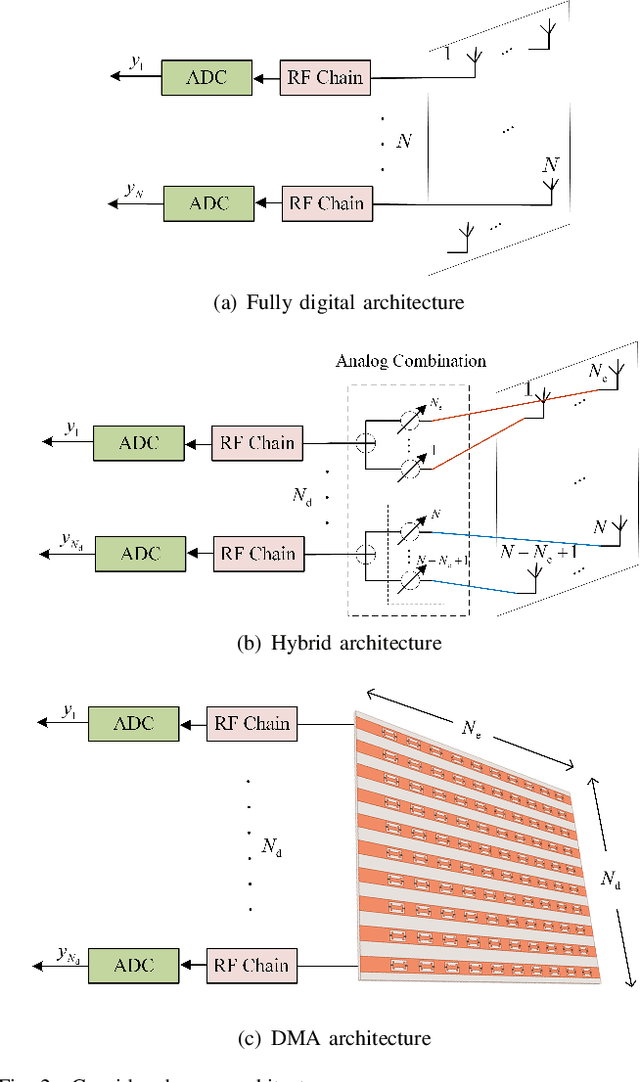
Abstract:Extremely large-scale antenna arrays are poised to play a pivotal role in sixth-generation (6G) networks. Utilizing such arrays often results in a near-field spherical wave transmission environment, enabling the generation of focused beams, which introduces new degrees of freedom for wireless localization. In this paper, we consider a beam-focusing design for localizing multiple sources in the radiating near-field. Our formulation accommodates various expected types of implementations of large antenna arrays, including hybrid analog/digital architectures and dynamic metasurface antennas (DMAs). We consider a direct localization estimation method exploiting curvature-of-arrival of impinging spherical wavefront to obtain user positions. In this regard, we adopt a two-stage approach configuring the array to optimize near-field positioning. In the first step, we focus only on adjusting the array coefficients to minimize the estimation error. We obtain a closed-form approximate solution based on projection and the better one based on the Riemann gradient algorithm. We then extend this approach to simultaneously localize and focus the beams via a sub-optimal iterative approach that does not rely on such knowledge. The simulation results show that near-field localization accuracy based on a hybrid array or DMA can achieve performance close to that of fully digital arrays at a lower cost, and DMAs can attain better performance than hybrid solutions with the same aperture.
Holographic Imaging with XL-MIMO and RIS: Illumination and Reflection Design
Dec 18, 2023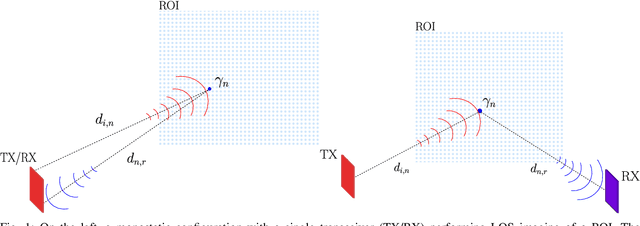

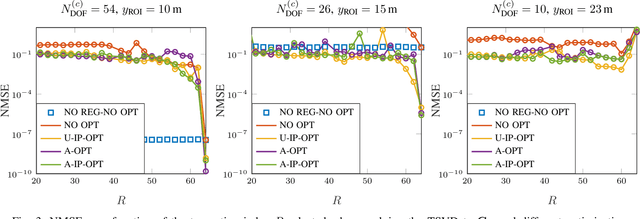
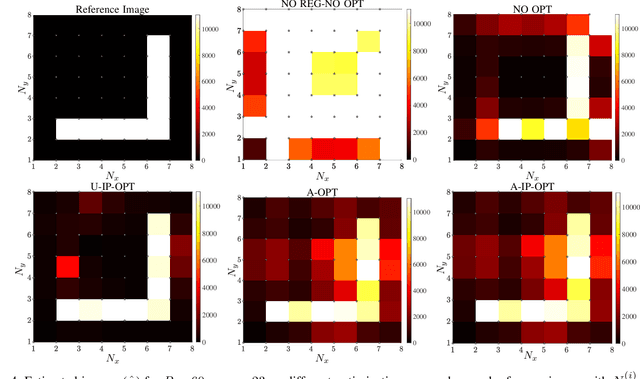
Abstract:This paper addresses a near-field imaging problem utilizing extremely large-scale multiple-input multiple-output (XL-MIMO) antennas and reconfigurable intelligent surfaces (RISs) already in place for wireless communications. To this end, we consider a system with a fixed transmitting antenna array illuminating a region of interest (ROI) and a fixed receiving antenna array inferring the ROI's scattering coefficients. Leveraging XL-MIMO and high frequencies, the ROI is situated in the radiating near-field region of both antenna arrays, thus enhancing the degrees of freedom (DoF) of the illuminating and sensing channels available for imaging, here referred to as holographic imaging. To further boost the imaging performance, we optimize the illuminating waveform by solving a min-max optimization problem having the upper bound of the mean squared error (MSE) of the image estimate as the objective function. Additionally, we address the challenge of non-line-of-sight (NLOS) scenarios by considering the presence of a RIS and deriving its optimal reflection coefficients. Numerical results investigate the interplay between illumination optimization, geometric configuration (monostatic and bistatic), the DoF of the illuminating and sensing channels, image estimation accuracy, and image complexity.
Near-field Localization with Dynamic Metasurface Antennas
Oct 28, 2022



Abstract:Sixth generation (6G) cellular communications are expected to support enhanced wireless localization capabilities. The widespread deployment of large arrays and high-frequency bandwidths give rise to new considerations for localization applications. First, emerging antenna architectures, such as dynamic metasurface antennas (DMAs), are expected to be frequently utilized thanks to the achievable high angular resolution and low hardware complexity. Further, wireless localization is likely to take place in the radiating near-field (Fresnel) region, which provides new degrees of freedom, because of the adoption of arrays with large apertures. While current studies mostly focus on the use of costly fully-digital antenna arrays, in this paper we investigate how DMAs can be applied for near-field localization of a single user. We use a direct positioning estimation method based on curvature-of-arrival of the impinging wavefront to obtain the user location, and characterize the effects of DMA tuning on the estimation accuracy. Next, we propose an algorithm for configuring the DMA to optimize near-field localization, by first tuning the adjustable DMA coefficients to minimize the estimation error using postulated knowledge of the actual user position. Finally, we propose a sub-optimal iterative algorithm that does not rely on such knowledge. Simulation results show that the DMA-based near-field localization accuracy could approach that of fully-digital arrays at lower cost.
Beamforming Design for Integrated Sensing and Wireless Power Transfer Systems
Oct 28, 2022Abstract:This letter proposes a new concept of integrated sensing and wireless power transfer (ISWPT), where radar sensing and wireless power transfer functions are integrated into one hardware platform. ISWPT provides several benefits from the integrating operation such as system size, hardware cost, power consumption, and spectrum saving, which is envisioned to facilitate future 6G wireless networks. As the initial study, we aim to characterizing the fundamental trade-off between radar sensing and wireless power transfer, by optimizing transmit beamforming vectors. We first propose a semi-definite relaxation-based approach to solve the corresponding optimization problem globally optimal, and then provide a low-complexity sub-optimal solution. Finally, numerical results verify the effectiveness of our proposed solutions, and also show the trade-off between radar sensing and wireless power transfer.
 Add to Chrome
Add to Chrome Add to Firefox
Add to Firefox Add to Edge
Add to Edge